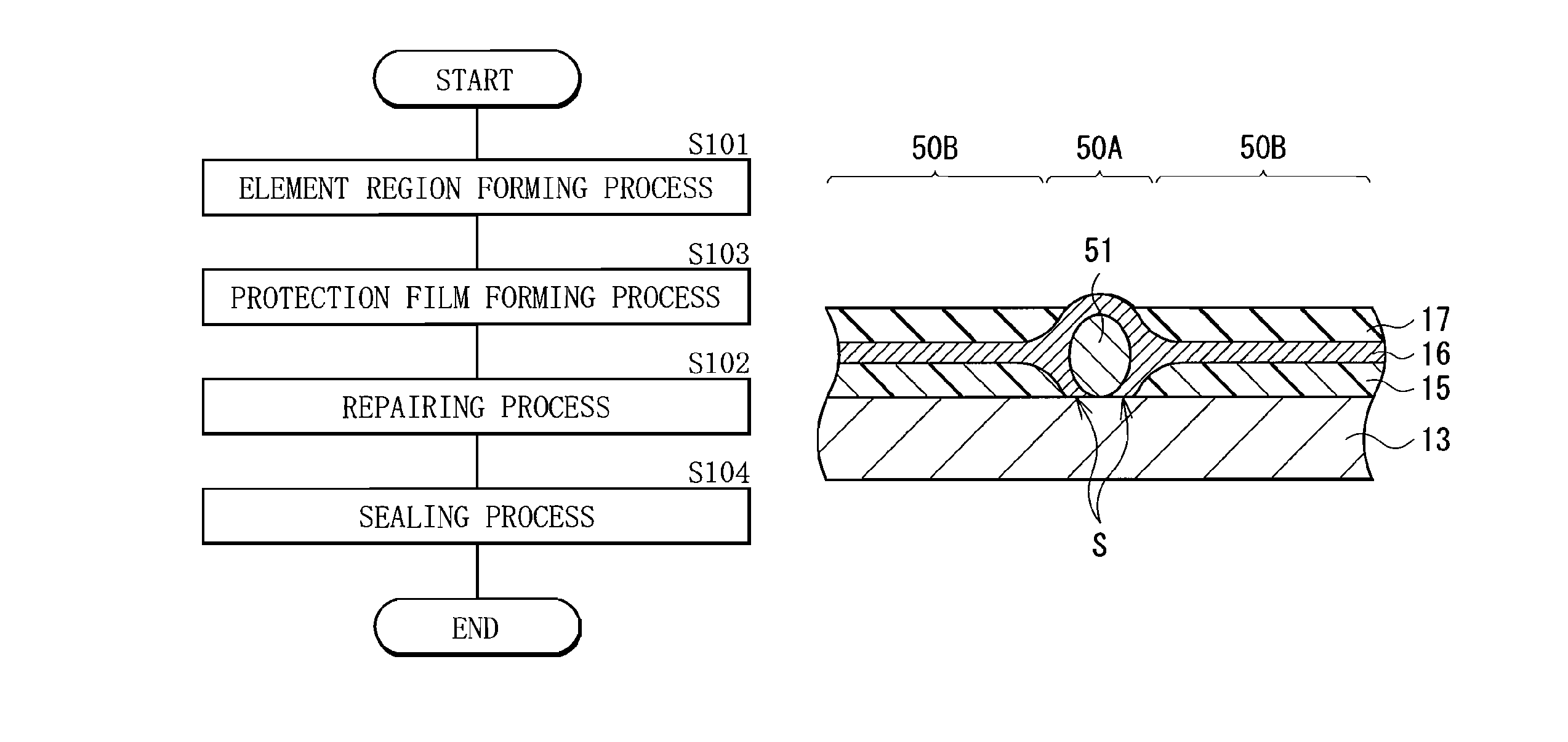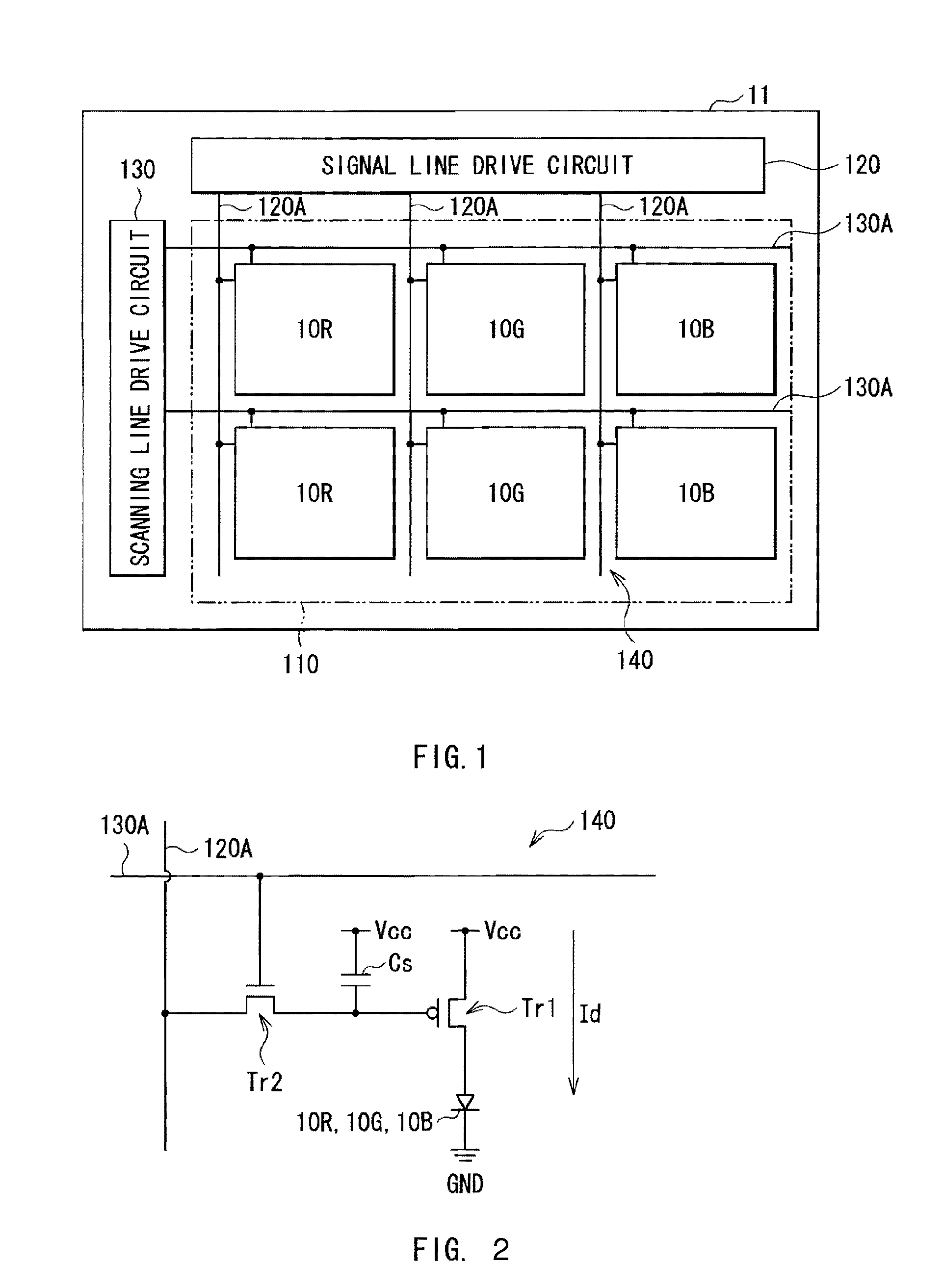Method of manufacturing organic light-emitting device
a technology of light-emitting devices and organic materials, which is applied in the direction of organic semiconductor devices, thermoelectric devices, electroluminescent light sources, etc., can solve the problems of display defect, high probability of existence of display defect in one screen, etc., and achieve high temperature dependence of i-v characteristics, high repair effect, and suppress temperature rise or current rise
- Summary
- Abstract
- Description
- Claims
- Application Information
AI Technical Summary
Benefits of technology
Problems solved by technology
Method used
Image
Examples
first embodiment
[0039]FIG. 1 shows the configuration of an organic light-emitting device manufactured by a method of manufacturing an organic light-emitting device as a first embodiment of the present invention. The organic light-emitting device is used as an organic EL television and is formed as follows. For example, on a drive substrate 11 made of glass, an element region 110 in which a plurality of organic electroluminescence elements 10R, 10G, and 10B to be described later are disposed in a matrix is formed. A signal line drive circuit 120 and a scanning line drive circuit 130 as drivers for displaying a video image are formed in the peripheries of the element region 110.
[0040]A pixel drive circuit 140 is formed in the element region 110. FIG. 2 shows an example of the pixel drive circuit 140. The pixel drive circuit 140 is an active-type drive circuit having a drive transistor Tr1 and a write transistor Tr2 formed as a layer under an anode 13 which will be described later, a capacitor (holdin...
modification 1
[0068]FIG. 10 shows the flow of a method of manufacturing an organic light-emitting device of a first modification of the present invention. The first modification is similar to the first embodiment except that, after the element region forming process, at least a part of the protection film 17 is formed before the repairing process, and the same actions and effects are obtained. Therefore, the modification will be described by assigning the same reference numerals to the corresponding components.
Element Region Forming Process (Step S101).
[0069]First, in a manner similar to the first embodiment, over the drive substrate 11, the pixel drive circuit 140 including the drive transistor Tr1 and the element region 110 including the organic electroluminescence elements 10R, 10G, and 10B are formed.
Protection Film Forming Process (Step S103)
[0070]Subsequently, for example, by the CVD method, the protection film 17 made of the above-described material is formed. The thickness of the protecti...
second embodiment
[0074]FIG. 12 shows the flow of a method of manufacturing an organic light-emitting device of a second embodiment of the present invention. The second embodiment is similar to the first embodiment except for the repairing process, and the actions and effects of the second embodiment are the same as those of the first embodiment. Therefore, the second embodiment will be described by assigning the same reference numerals to the corresponding components.
Element Region Forming Process (Step S101).
[0075]First, in a manner similar to the first embodiment, over the drive substrate 11, the pixel drive circuit 140 including the drive transistor Tr1 and the element region 110 including the organic electroluminescence elements 10R, 10G, and 10B are formed.
Repairing Process (Step S202)
[0076]Subsequently, as shown in FIG. 13, the element region 110 is temporarily sealed by using a seal layer 51 and a shield substrate 52.
[0077]First, by applying an adhesive resin or sticky region to the periphery...
PUM
 Login to View More
Login to View More Abstract
Description
Claims
Application Information
 Login to View More
Login to View More - R&D
- Intellectual Property
- Life Sciences
- Materials
- Tech Scout
- Unparalleled Data Quality
- Higher Quality Content
- 60% Fewer Hallucinations
Browse by: Latest US Patents, China's latest patents, Technical Efficacy Thesaurus, Application Domain, Technology Topic, Popular Technical Reports.
© 2025 PatSnap. All rights reserved.Legal|Privacy policy|Modern Slavery Act Transparency Statement|Sitemap|About US| Contact US: help@patsnap.com



